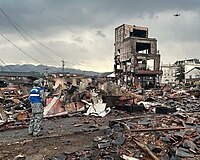
Photo from wikipedia
Details of Pacific plate subduction under the Japan Sea and associated current seismicity remain challenging. Seismic tomography reveals a continuous slab dipping at ~30° down to ~600 km, and earthquake mechanisms… Click to show full abstract
Details of Pacific plate subduction under the Japan Sea and associated current seismicity remain challenging. Seismic tomography reveals a continuous slab dipping at ~30° down to ~600 km, and earthquake mechanisms point to down-dip compression. Further, the slab is lying at the 660-km discontinuity, and this zone is aseismic. We suggest that this pattern results from the slab’s negative thermal buoyancy, resistance of the viscous lower mantle, and buoyancy forces associated with the phase transitions at 410 km and 660 km. Our model comprises an ageing subducting plate, nonlinear rheology and major phase transitions. The model explains the observed low dip angle of the slab and predicts a detailed stress pattern related to bending down to 450 km, followed by unbending as the slab is laid flat upon the 660 km boundary. Remarkably, in the bending/unbending regions, down-dip compression occurs close to the slab top/bottom, respectively. As only down-dip compression is observed, we argue that the earthquakes are mapping the top and bottom of the slab. The absence of seismicity in the flat-lying slab is explained by significantly lower stresses and higher temperatures. With this new knowledge, increasingly accurate seismic locations will considerably improve images of finite-extent slab geometry.
Journal Title: Scientific Reports
Year Published: 2020
Link to full text (if available)
Share on Social Media: Sign Up to like & get
recommendations!